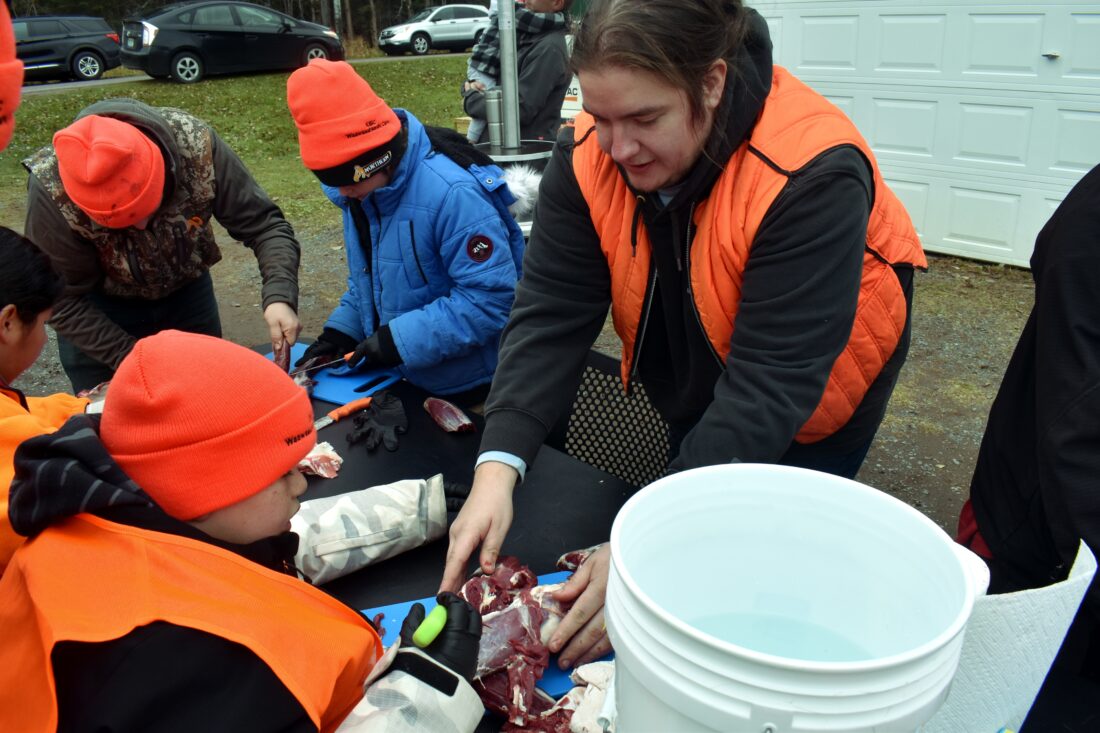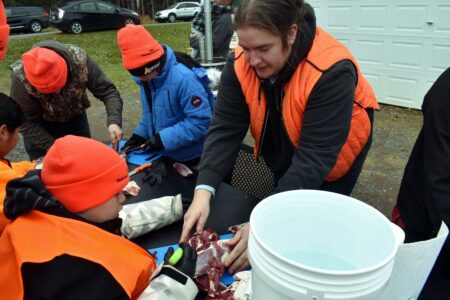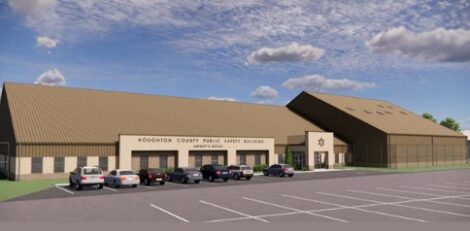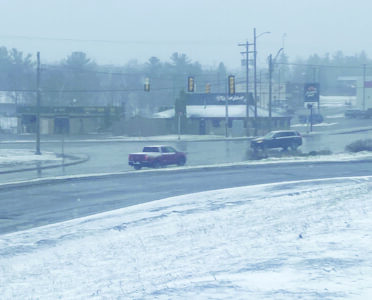Keeping traditions alive
KBIC Waawaashkeshi teaches deer harvesting

Ben Garbacz/Daily Mining Gazette KBIC Natural Resources Outreach Coordinator Austin Ayres teaches a camp participant how to properly cut venison at the annual Waawaashkeshi Saturday.
L’Anse — The annual Waawaashkeshi, or Deer Camp, was held by the Keweenaw Bay Indian Community (KBIC) Natural Resources Department, Keweenaw Bay Ojibwa Community College (KBOCC), Great Lakes Indian Fish and Wildlife Commission and Tribal Police at the KBIC Teaching Facility. The camp instructed novice or soon-to-be hunters how to process and prepare deer after a successful hunt. Over fifty participants learned about deer harvesting, along with Anishinaabe traditions and stories about deer and state and tribal regulations for deer hunting. The camp is put on each year to inspire youth to take up the tradition of deer hunting and learn its value of self reliance.
Two does were harvested prior to the camp to be used for participants from both tribal and non-tribal backgrounds to watch demonstrations on skinning and butchering. Once the pieces of venison were separated into manageable chunks, camp participants were able to cut away edible pieces themselves. All pieces were then bagged up for them to bring home although the backstraps were marinated, skewered and cooked over a campfire for everyone to enjoy. KBIC Natural Resources Department Wildlife Biologist Blake Chosa taught cutting practices for the campers, and said it was good to have a strong focus on deer processing.
“I feel like a lot of media these days really focuses on, at least not historically, it all focuses about the killing and the hunt aspect of it, and not much really [much] on the after part,” Chosa said. “People are not hunting as much anymore, and it’s tougher to recruit young hunters or have information to be passed on in the next generation. So for this camp it is really important to stress the other half that isn’t being taught or just hasn’t been taught yet.”
Chosa explained it is also vital for younger hunters to be exposed to this type of harvest due to healthier choices when it comes to eating. “It’s all naturally grown. It’s the Creator’s gift to us, or the universe, or evolution or whatever you believe in. Deer are a natural thing without human interference and influence to juice everything out. Deer are clean, lean and healthy and when you eat them you too are clean and healthy. It’s historically what our ancestors lived off of, and that’s how we came to be because they survived off it. We can still survive off it and be healthier by eating this leaner meat and gardening,” Chosa said.
KBIC Natural Resources Department Outreach Coordinator Austin Ayres said the Anishinaabe people see themselves as part of the landscape instead of living at the top of the food chain. “For us to continue hunting deer and to continue hunting anything is really just an expression of, ‘Hey, we’re part of nature, and we’re acting as part of nature,'” Ayres explained. “It’s based in respect. We have long standing agreements with these animals and with the Creator to say ‘We’re going to keep doing our work to support all walks of life, all creatures of creation, all beings, as long as we get to be supported by them as well.'”
Ayres described hunting and harvesting as an admission humans too are animals, and they too belong in nature instead of being separate from it. He also sees the camp as a good way to teach people to focus on the resources hunting provides instead of fixating on obtaining a trophy. Ayres believes state regulations kind of enforce a sort of thinking of targeting large bucks instead of focusing on food.
“A bullet’s cheaper than a steak,” he said. “There’s a lot of extra work that goes into it. But I think just that food security of knowing that, ‘Hey, I can provide for myself,’ and up here in the U.P. especially, it’s pretty remote, and there’s certain areas you know that for a long time, they didn’t have necessarily all the amenities or infrastructure that other places had. So to deer hunt was just to survive.”
While the participants were cutting meat, they fed on moose chili and discussed recipes for the venison they could try at home and Chosa shared his favorite recipe. It calls for venison backstraps to be marinated in Worcester sauce, brown sugar and minced garlic. Once marinated, sprinkle whichever preferred seasoning the cook desires on top of the venison then butterfly it. Marinade it once more, add the seasoning and then spread cream cheese and chopped jalapeños on the meat. Roll the venison up tight, and then wrap it up in bacon and sear the piece on all sides. Throw the pieces into the oven at 325 degrees Fahrenheit and let cook until the desired char.
The camp also informed campers and their parents or guardians of chronic wasting disease (CWD). Chosa wants to remind all hunters of the CWD checkpoints KBIC’s Natural Resources Department is overseeing. Hunters can check in their deer to Woodlands Firearms and Supply in Baraga and Kurt’s Korner Store in Pelkie during business hours from Nov. 15 to 24. The deer’s lymph nodes will be extracted for testing to see if the deer are safe for consumption. The nodes will be sent to a lab in the University of Wisconsin in Madison where results will be sent back within seven days. Those who participate will received a deer patch from the KBIC Natural Resources Department, a $30 gas card to the Pines and a raffle entry for a gift certificate.
While the camp was indeed educational, Ayres said the tradition of deer hunting brings with it social opportunities and creates memories.
“I think a lot about myself as a kid and my own experiences and my own memories with it,” he said. “The skill itself is very valuable, but those memories are much more valuable. So I see these kids making memories, and I hope that it leads to many, many, many more memories like going out with their buddies, or their first big deer, or the first time they go and feed an elder. [I’m] just listening to their stories, and just taking that time to be in that moment, and recognizing my role. I think a lot of these younger kids here are realizing that’s going to be their role and they’re going to have to step up and start providing, feeding and putting food on the table.”
Ayres encourages anyone to consider coming to next year’s camp for an educational opportunity, a unique dining experience and community bonding.




